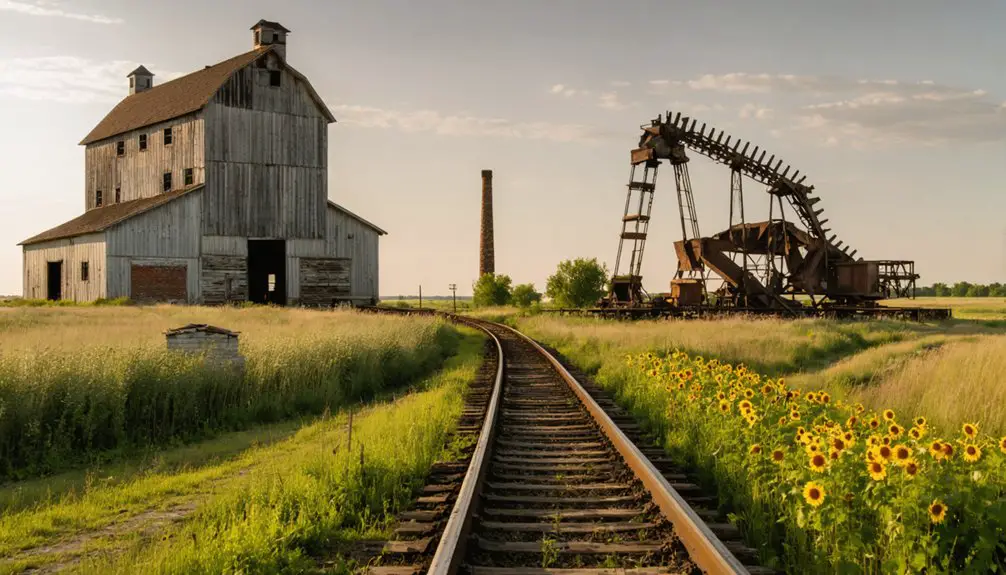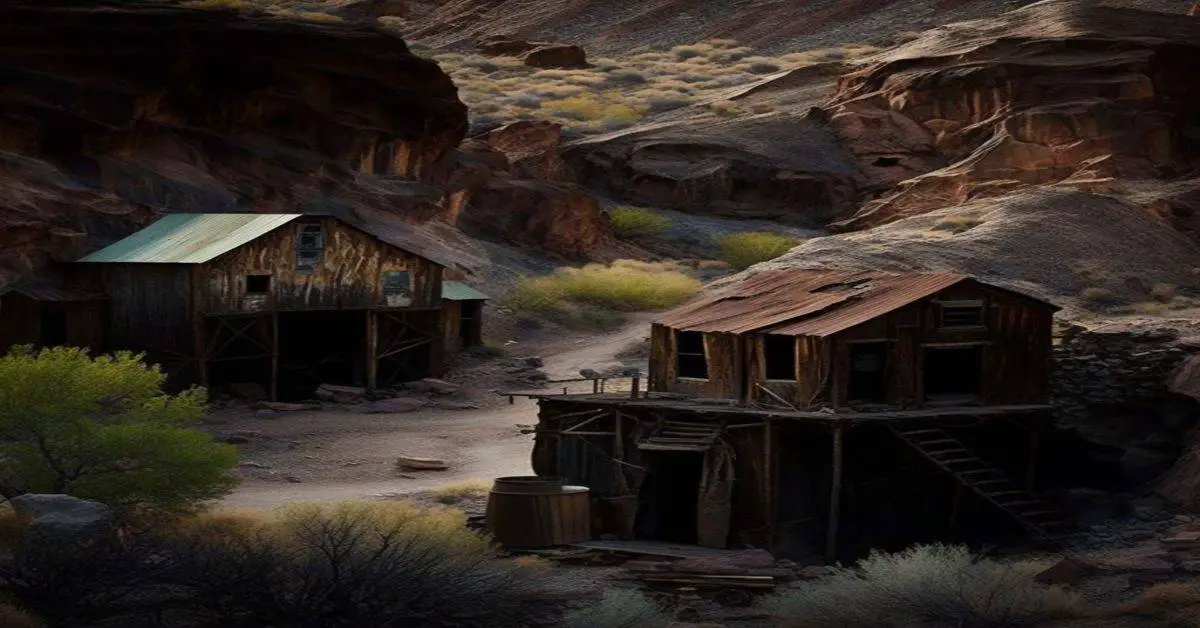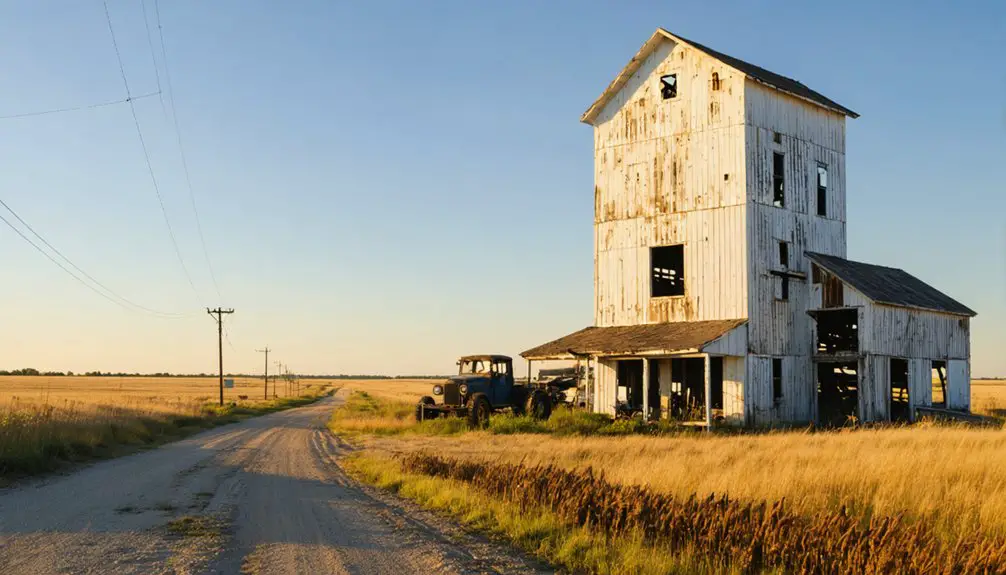You’ll find Sims, North Dakota 35 miles west of Mandan, where a bustling mining town of over 1,000 residents once thrived. Founded in 1883 as Bly’s Mine, this frontier settlement drew Scandinavian immigrants who worked the coal mines and established a prominent Lutheran church. Though the last resident departed between 2005-2012, the restored 1884 church still stands among crumbling structures, while local legends speak of supernatural encounters within the abandoned townsite.
Key Takeaways
- Sims, North Dakota, established in 1883 as a coal mining town, is now a ghost town with its last resident leaving between 2005-2012.
- The town’s population peaked at over 1,000 during its mining heyday but drastically declined to 86 residents by 1910.
- The historic Sims Scandinavian Lutheran Church, built in 1884, remains the most prominent landmark and still holds biweekly services.
- Economic decline occurred due to mining industry downturn, Great Depression, and increased competition from larger coal operations.
- The site features a restored church, crumbling brick home, and is known for ghost stories, particularly the “Gray Lady” haunting.
The Rise of a Mining Frontier Town

When the Northern Pacific Railroad established a water and coal refueling station in 1879, it set the stage for Sims’ emergence as a frontier mining town.
By 1883, you’d find hardy Scandinavian immigrants staking their claim in what was then known as Bly’s Mine or “Baby Mine,” located 35 miles west of Mandan in Dakota Territory.
The town’s mining methods centered on easily accessible coal deposits, while a bustling brickyard diversified the local economy.
Miners tapped into rich coal seams near the surface while local craftsmen shaped clay into bricks, building a diverse economic foundation.
Community resilience shone through as settlers built their homes and transformed railroad boxcars into businesses.
The establishment of the Sims Scandinavian Lutheran Church in 1884 marked a significant milestone, reflecting the strong cultural bonds of the town’s pioneers.
Within years, this remote outpost grew into a thriving community of over 1,000 residents.
From Boom to Bust: A Population’s Decline
You’ll find Sims’ rapid transformation from a bustling frontier town to near abandonment reflected in its population numbers, which plummeted from over 1,000 residents during its mining heyday to just 86 by 1910.
As coal mining operations and the brickyard industry declined, working-age adults left town in search of opportunities elsewhere, leading to decades of steady population loss that continued through the Great Depression and Dust Bowl years.
The town’s final chapter as an inhabited place came to a close between 2005 and 2012, when its last resident abandoned their mobile home, leaving only the historic Lutheran church to mark Sims’ existence.
Mining Dreams Fade Away
Despite initial optimism surrounding Sims’ coal mining prospects in the 1870s, the town’s economic dreams gradually faded into the harsh reality of limited growth.
You’d have found pioneering miners like Dennis Hannifin establishing early claims, with mining techniques focused on extracting lignite coal from modest veins west of Bismarck.
While the Northern Pacific Coal Company’s Baby Mine showed promise, producing 100 tons daily by 1884, labor struggles and technological limitations hindered significant expansion.
The mine’s workforce, largely comprised of immigrants, faced challenging conditions until safety regulations emerged in 1907. Yet these improvements couldn’t overcome the fundamental constraints of thin coal seams and increasing competition from larger operations elsewhere.
Population’s Dramatic Drop
As the 1930s ushered in environmental catastrophe and economic turmoil, North Dakota’s population plummeted by over 20%, with nearly 150,000 residents abandoning their homes between 1930 and 1944.
You’ll find that this dramatic exodus hit small mining towns like Sims particularly hard, as economic factors drove widespread population migration across the Great Plains.
While the U.S. population grew by 14% during this period, North Dakota’s demographic landscape transformed permanently.
The loss of young adults aged 20-40 severely impacted future birth rates, and even the post-war Baby Boom only brought a modest 12% recovery.
Today, you can witness this legacy in places like Sims, where the once-bustling streets stand empty – a stark reminder of how environmental hardship and economic instability can reshape entire communities.
Last Residents Leave Town
While Sims once thrived as a bustling mining community, its final chapter began with the closure of the post office in 1947.
You’ll find that this marked the beginning of the town’s last memories, as administrative functions shifted to nearby Almont and Sims lost its distinctive zip code.
The town’s final farewells played out over decades, with the population steadily dwindling as residents sought opportunities elsewhere.
By 2005, only a single mobile home remained occupied in the town center, standing as a lonely symbol to Sims’ fading existence.
When this last dwelling was removed in 2012, it marked the definitive end of residential life within the original town boundaries.
Today, while nearby farms continue operations, they lie beyond the town limits, leaving Sims truly empty.
Historic Landmarks and Architectural Legacy
When Sims was established in 1883 as Bly’s Mine, the town’s architectural landscape began with makeshift structures fashioned from Northern Pacific Railroad boxcars.
You’ll find the town’s architectural significance centered on the Scandinavian Lutheran Church, built in 1884 and rebuilt in 1896, making it one of the oldest Lutheran churches west of the Missouri River.
The original parsonage, which first served as both church and clergy residence, now houses the Sims Historical Society Museum.
A historic dual-purpose parsonage now preserves local memories as the home of Sims’ museum collection.
Through dedicated historical preservation efforts, these landmarks still stand as evidence to the town’s frontier heritage.
While most of Sims’ buildings have vanished, including homes and businesses that once supported a population of over 1,000, the church and parsonage remain as crucial links to North Dakota’s rural past.

When you explore Sims’ Scandinavian heritage, you’ll find the Lutheran Church stands as its most enduring cultural landmark, serving the community continuously since 1884 with services now held every other Sunday.
You can trace the settlement patterns of Scandinavian families who first established themselves in Minnesota, Wisconsin, and Iowa before making their final migration to Sims in search of homesteading opportunities.
The strong Lutheran faith and Scandinavian customs of these settlers shaped the town’s identity through their traditional practices, including Norwegian-language services that continued until 1946.
Lutheran Church Legacy Endures
Standing as a testimony to North Dakota’s rich Scandinavian heritage, the Sims Lutheran Church emerged in 1884 when 35 men and 8 women pioneered its establishment. The church’s cultural significance endures through its distinction as the oldest Lutheran church west of the Missouri River in North Dakota.
You’ll find the church’s preservation reflects the deep commitment to Scandinavian traditions:
- Services were conducted in Norwegian until 1946, preserving immigrant heritage
- The original parsonage doubled as worship space until 1900
- Today’s congregation of 50 members maintains bi-weekly services
Despite Sims becoming a ghost town, the 2006 restoration effort, powered by 2,000 volunteer hours and preservation grants, guarantees this landmark continues sharing the story of Scandinavian pioneers who shaped North Dakota’s spiritual landscape.
Cultural Festivals and Traditions
Throughout North Dakota’s cultural landscape, the vibrant celebration of Scandinavian heritage takes center stage at the Norsk Høstfest, North America’s largest Nordic festival held annually in Minot.
You’ll experience authentic cultural traditions through folk music, traditional dance performances, and hands-on artisan craft workshops. The festival’s commitment to preserving heritage shines through its showcase of Norwegian rosemaling, textile arts, and woodworking.
When you visit these celebrations, you’ll discover delicious Nordic cuisine that reflects the region’s immigrant roots. Local markets feature handmade Scandinavian-inspired goods, while cultural clubs keep traditional music and dance alive through intergenerational participation.
In 2025, the Norsk Høstfest will mark a significant milestone: 200 years since the first organized Norwegian immigration to North America, highlighting the enduring impact of Scandinavian culture in North Dakota.
Settlement Family Migration Patterns
The Scandinavian migration to North Dakota began with Norwegian settlers arriving in the Red River Valley in 1869, marking the start of a transformative cultural shift that would shape communities like Sims.
Family dynamics played a vital role, as Norwegian inheritance customs pushed younger sons to seek new opportunities abroad.
Migration motivations centered on three key factors:
- Access to affordable farmland through homesteading opportunities
- Growing coal mining jobs alongside the expanding railroad
- Established support networks of extended family and fellow countrymen
Tales of the Supernatural

Among North Dakota’s most intriguing ghost towns, Sims harbors supernatural tales centered on its historic Scandinavian Lutheran Church and parsonage.
Located 50 miles west of Mandan, Sims stands as one of the best preserved ghost towns in the region.
You’ll find the most famous ghostly encounters revolve around the “Gray Lady,” believed to be Bertha Dordal’s spirit, who’s known for moving upstairs, opening windows, and playing a phantom organ.
The supernatural folklore gained official attention in 1938 when Pastor Nelson’s wife, Olga, witnessed a gray shape and an inexplicably moving pump handle, prompting a church investigation.
Today, you’ll still hear reports of unexplained footsteps and thumping sounds in these buildings, which remain active with biweekly services.
As with many ghost towns of ND, exploring abandoned places creates a mix of fascination and fear while documenting history.
While exploring Sims, you might experience the benign but persistent presence that’s made this one of North Dakota’s creepiest ghost towns.
Present-Day Ghost Town: What Remains
Standing proudly against North Dakota’s rolling grasslands, Sims’ historic Scandinavian Lutheran Church remains the ghost town‘s most prominent landmark.
The restored 1884 structure anchors what’s left of this once-thriving community, now reduced to just a handful of abandoned structures. You’ll find the adjacent parsonage serving as the Historical Society’s museum, while worship services continue every other Sunday despite congregants living elsewhere.
- A crumbling brick home stands as one of the last residential remnants
- Two repurposed houses near the old railroad bridge now shelter ranch cattle
- The former townsite has largely returned to nature, with only traces of its mining past visible
Rural tourism occasionally brings visitors to explore Sims’ quiet streets, especially since First Lady Laura Bush’s 2008 visit highlighted the historic church’s significance.
Frequently Asked Questions
What Was the Average Annual Coal Production During Sims’ Peak Mining Years?
You’ll find average coal production during peak years was relatively modest, under one million tons annually, using early mining techniques like underground extraction before surface mining became dominant.
How Did Local Native American Tribes Interact With Early Sims Settlers?
You’ll find that Dakota and Lakota tribes, who occupied this land for generations, had limited cultural exchange and trade relationships with early settlers, though tensions grew as railroad development increasingly displaced native communities.
What Were the Primary Causes of Death Recorded in Sims’ Cemetery?
You’ll find records showing deaths primarily from disease outbreaks like tuberculosis and influenza, mining accidents in the local coal operations, and harsh winter exposure among early settlers during Sims’ peak years.
Which Businesses and Stores Operated in Downtown Sims During the 1890S?
You’d find the Northern Pacific Coal Company offices in the hotel, plus businesses in converted boxcars, a general store, and blacksmith shop serving miners and railroad workers.
Did Any Notable Crimes or Significant Law Enforcement Incidents Occur in Sims?
You won’t find any documented crimes or significant law enforcement incidents in historical records. The town’s crime history mainly revolves around ghost stories that weren’t treated as law enforcement matters.
References
- https://en.wikipedia.org/wiki/Sims
- https://ghostsofnorthdakota892857007.wordpress.com/category/sims-nd/
- https://news.prairiepublic.org/show/dakota-datebook-archive/2022-05-02/gray-lady-of-sims
- https://www.lostamericana.com/sims-north-dakota/
- https://www.onlyinyourstate.com/experiences/north-dakota/sims-ghost-town-nd
- https://photobyjohnbo.com/2022/02/22/sims-north-dakota/
- https://almont.us
- https://www.ndcompass.org/trends/Data-Highlight/Data-Highlight.php
- https://www.nd.gov/statedatahub/data-story-population-growth-2012-2022
- https://www.library.nd.gov/statedocs/HumanServices/AgingNDServices-20120626.pdf



